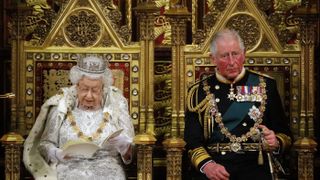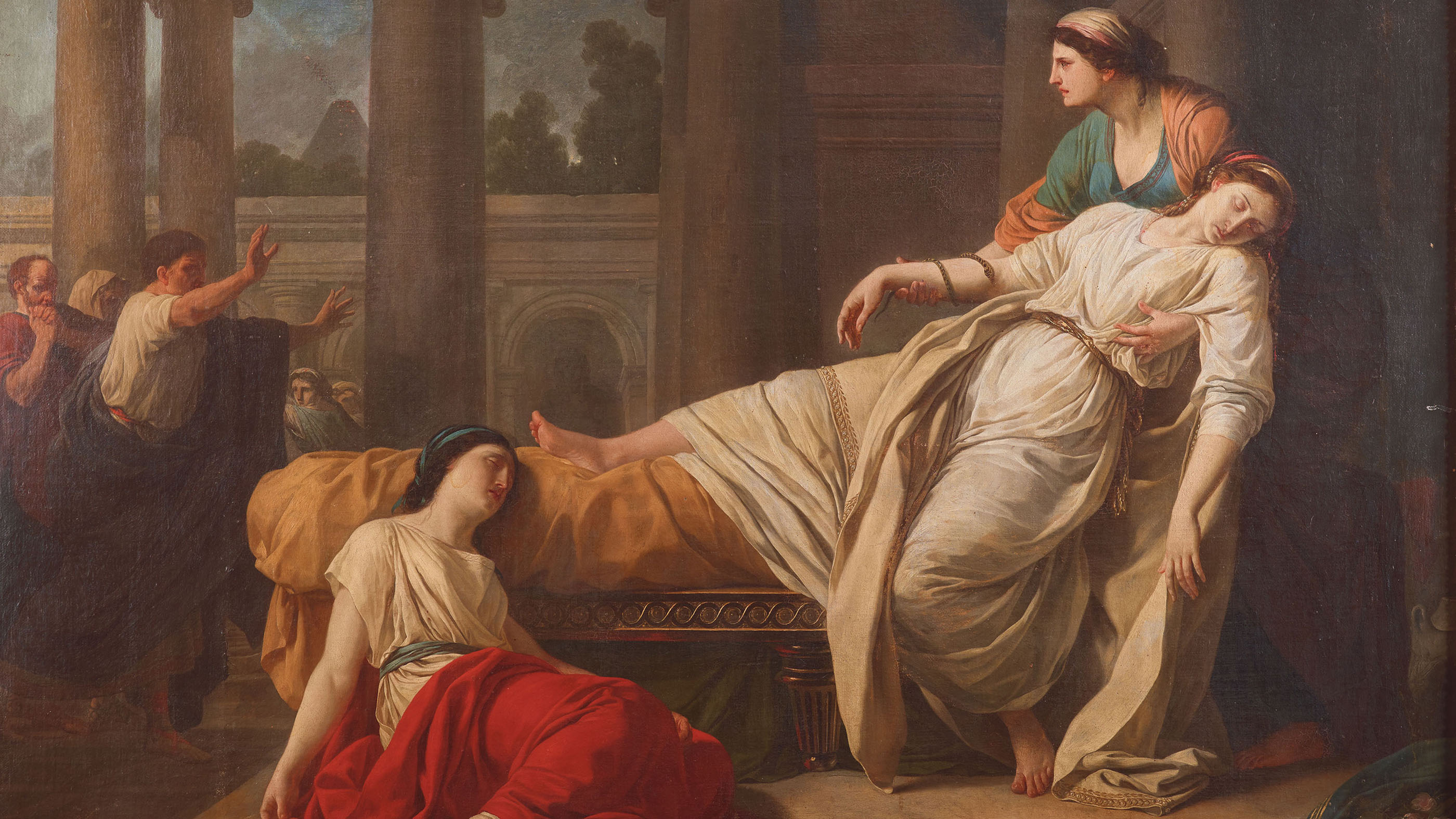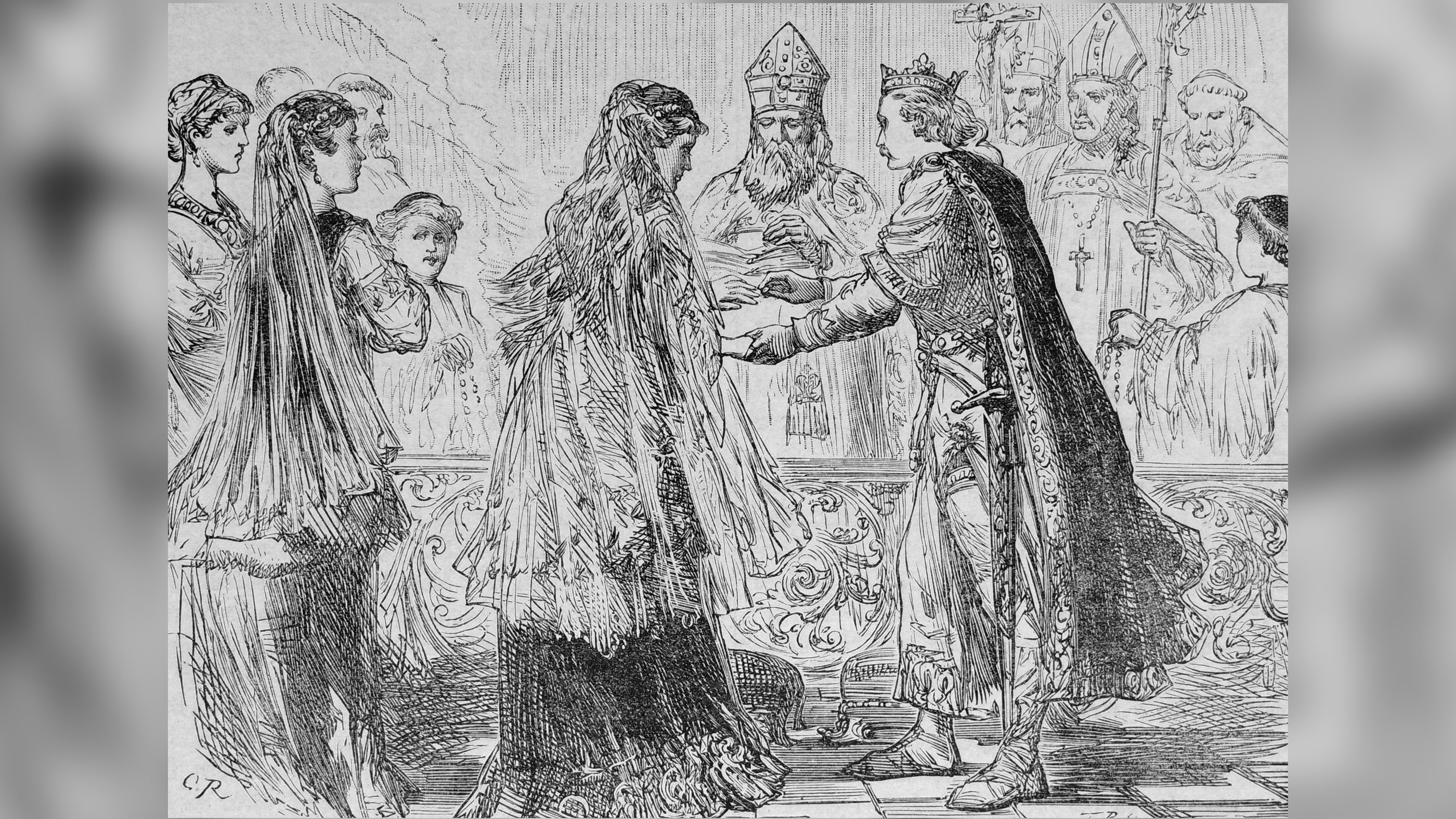Which Two Cultures Believed Their Royal Families Were Descendants of the Sun Deity?
eight truly dysfunctional royal families

The British royal family unit is plenty familiar with scandals and depravity, from Prince Charles' affair with his current wife Camilla Parker Bowles, to Prince Harry being photographed wearing a Nazi costume to the extreme coldness and racism alluded to in the Oprah Winfrey interview with Duchess Meghan Markle, wife of Prince Harry.
Merely a great number of kings and queens throughout history have been complicit in evil-doings and just bad choices, including palace assassinations and serial marriages. Castle walls take seen it all.
1. Cleopatra'south bloody offset

Cleopatra is famous for her suicidal ending. What's less known is her encarmine beginning — and the familial drama that brought her to power.
Afterward her father's expiry, Cleopatra's younger brother Ptolemy XIII inherited the throne. She was meant to marry him, inbreeding beingness 1 mode ancient regal families kept a grip on power. But her ambitions threatened him, and he had her exiled, according to Stacy Schiff'due south "Cleopatra" (Fiddling, Chocolate-brown and Company, 2010). So Cleopatra centrolineal with Julius Caesar, retaking the throne with her other younger brother, Ptolemy Fourteen. That younger brother later died; Cleopatra may have poisoned him. She also had her younger sis Arsinoe Iv, some other rival, killed in 41 B.C.
Mortiferous sibling rivalry was common in the Ptolemy dynasty, according to Schiff. The complex family trees occasioned by inbreeding caused succession crisis after succession crisis, typically with mortiferous results.
"Information technology was rare to find a member of the family who did not liquidate a relative or two," Schiff wrote.
2. Macedonian mayhem

Another surefire way to rile up a royal family is to have lots and lots of wives, all of which would like to see their own children installed on the throne. Alexander the Smashing's father, Philip II of Macedon, probably had seven wives, including Alexander's mother, Olympias.
Olympias may have had something to do with Philip II'southward assassination by a bodyguard in 336 B.C., according to some ancient historians, only the truth is fuzzy. According to a after account by the historian Cleitarchus, the bodyguard was a former lover of Philip 2, who had taunted the king's new, younger, lover into suicide. Philip Ii'due south uncle-in-police allegedly sexually assaulted the bodyguard in retaliation, leading the bodyguard to kill Philip II in his own quest for revenge.
Any actually happened, the Macedonian family unit dysfunction did not end with Philip 2's generation. Alexander quickly started putting rival family members to death to secure his ascension to the throne, and Olympias had Philip II'due south last married woman and her children killed. After Alexander died in 323 B.C., leaving a pregnant married woman but no certain heir, his mentally disabled half-blood brother Philip Three Arrhidaios (besides spelled Arrhidaeus) was installed on the throne. Philip Three'south wife Eurydice attempted to plough this figurehead rex into a existent ruler; this put her in competition with Olympias in the ensuing wars of succession. Ultimately, Philip 3 was executed on Olympias' orders, and Eurydice forced to commit suicide. Their bodies were buried and then dug up nearly 17 months later for a royal cremation and funeral.
Olympias would not escape the succession wars unscathed. Captured non long subsequently she had Philip III and Eurydice killed, she was stoned to death past relatives of people she had ordered executed.
3. Murder of a pharaoh

Harems are all fun and games until somebody gets their throat slit, every bit Ramesses Three learned the difficult fashion. This pharaoh ruled Egypt from 1186 B.C. to most 1156 B.C. — until somebody slashed his neck so deeply that modern archaeologists say he would have died instantly.
Ancient papyrus texts reveal that one of Ramesses Iii's small-scale wives, a woman named Tiye, was behind the plot; she was trying to get her son Pentaweret installed on the throne. Dozens of co-conspirators were sentenced to death, according to gimmicky records, including Pentaweret. Archaeologists reported in 2012 they may have plant the prince's mummy. The corpse in question has an agonized expression and overinflated lungs, consistent with decease by suffocation or strangulation. He may have been forced to commit suicide, or he may have been cached alive. [In Photos: The Mummy of Ramesses Iii]
4. War of brothers

A disharmonize called the War of the Two Brothers tin signal just one thing — a serious family unit meltdown. In 1527, the Inca king Huayna Capac died, leaving his kingdom to two of his sons, Atahualpa and Huáscar. (The two men had different mothers, as Inca rulers took multiple wives and concubines.)
Articulation rule did not work out and so well for the two new kings. By 1529, war broke out. Things got personal: According to Kim MacQuarrie'south volume "The Last Days of the Incas" (Simon & Schuster, 2008), Atahualpa at one indicate made a drinking cup out of the skull of one of Huáscar'south generals.
The Inca civil war would hurry along the downfall of this civilization. In 1532, Francisco Pizarro'south Castilian conquistadors appeared just as Atahualpa was declaring victory over his blood brother. The conquistadors captured Atahualpa and held him for ransom, though Atahualpa was able to get out an important guild to his people: Execute my brother.
Atahualpa wouldn't outlast Huáscar by much. The Spanish executed him in 1533. [Related: 10 epic battles that changed history]
5. The passive-ambitious emperor

Ever get the sense Mom and Dad like your brother or sister more? The kids of the Wanli Emperor had no dubiety. Wanli, the 13th emperor of China'southward Ming dynasty, had two official consorts and a great many concubines. His favorite concubine, Lady Zheng, had two sons, one of whom Wanli desperately wanted to follow him on the throne.
But the emperor's ministers wouldn't represent this son — Wanli's tertiary — equally heir. Ultimately, they prevailed, and Wanli was forced to declare his first son past his espoused Lady Wang the crown prince.
And and then the emperor did something very strange. He stopped working. Wanli had one time been a strong ruler, treatment internal rebellions and Japanese invasions with brio. The last xx years or so of his reign, however, were like an extended lame-duck period. In a passive-aggressive protest, Wanli spent decades ignoring meetings, memorandums and all other royal duties, according to a 2011 article in the New York Times. Unsurprisingly, this undermined the land. Many historians attribute the aging of the Ming dynasty in 1644 largely to the cocky-sabotage of Wanli's rule.
half dozen. Captive brother

William the Conquistador, the beginning Norman male monarch of England, had four sons. I died before him; William carve up his kingdom for his eldest remaining sons. Robert was given Normandy upon his male parent'due south decease, and William got the throne of England.
That left the youngest son, Henry. He may non have been granted a kingdom, simply Henry knew how to catch an opportunity. In 1100, William the younger died in a hunting accident while Robert was away on a cause. Within three days, Henry had himself crowned king of England (equally Henry I), chirapsia his absent brother to the punch, according to the official histories of the British monarchy.
Robert attempted to take England for himself, merely Henry I beat him back — so, a few years afterwards, took Normandy, too. Robert was captured, and Henry I kept him imprisoned for the residual of his life.
7. A murder mystery

Richard III, the last Plantagenet male monarch of England, was recently exhumed from underneath a parking lot in Leicester. The occasion was heralded by Richard's fans as an opportunity to better understand a king remembered by and large every bit a Shakespearian villain. Merely questions remain about Richard's ascension to power.
When King Edward IV died in 1483, he left backside two young sons. The eldest, Edward V, was just 12, so Richard Iii was declared his protector. After a 68-day reign, Edward and his younger brother Richard of Shrewsbury were sent to the Tower of London and then were never heard from again. Meanwhile, Richard III took the throne.
No one knows what happened to the boys, now known every bit "the Princes in the Tower." A widespread theory holds that Richard III had them murdered. Just no one has always found definitive proof of the princes' deaths (though two small skeletons were excavated from the belfry in 1674), and Richard himself died in boxing only 2 years later, taking his secrets to his hastily dug grave.
8. The many wives of Henry Eight

Divorced, beheaded, died. Divorced, beheaded, survived.
Those were the fates of Henry VIII's 6 wives. Family matters came to dominate the reign of this Tudor rex, who could non seem to secure himself a male person heir. Originally, Henry married Catherine of Aragon, his brother'due south widow. When the king's centre roved to the witty Anne Boleyn in the 1520s, his argument for divorce focused largely on whether Catherine had ever had sex activity with his brother.
The divorce case rocked the Catholic Church, triggering the English Reformation. Henry got his divorce, but Anne proved no more able to produce sons than Catherine (some modern physicians doubtable that Henry may have had a genetic disorder that caused his wives' many miscarriages). She was executed on trumped-upwards charges of treason, infidelity and incest, defendant of sleeping with her ain brother.
Henry would become on to marry four more times and would have one more than of his wives, Catherine Howard, killed for adultery. Ultimately, Henry's efforts to install a son on the throne were for naught; his ane male heir died as a teenager, simply nigh six years into his reign. Henry'southward great-niece Lady Jane Grey so took the crown for a mere ix days before being overthrown past his daughter by Catherine of Aragon, Mary I. After Mary I died five years into her reign, Anne Boleyn's daughter Elizabeth I ruled. Her reign was marked by tumult, but Henry's fear that a adult female could not hold the throne of England turned out to exist quite unfounded: Co-ordinate to the official history of the British Monarchy, the "Virgin Queen" was extremely pop, and the date of her accession to the throne became a national holiday.
Follow Stephanie Pappas on Twitter and Google+ . Follow us @livescience , Facebook & Google+ . Original article on Live Science.
Source: https://www.livescience.com/51156-8-dysfunctional-royal-families.html

0 Response to "Which Two Cultures Believed Their Royal Families Were Descendants of the Sun Deity?"
Postar um comentário